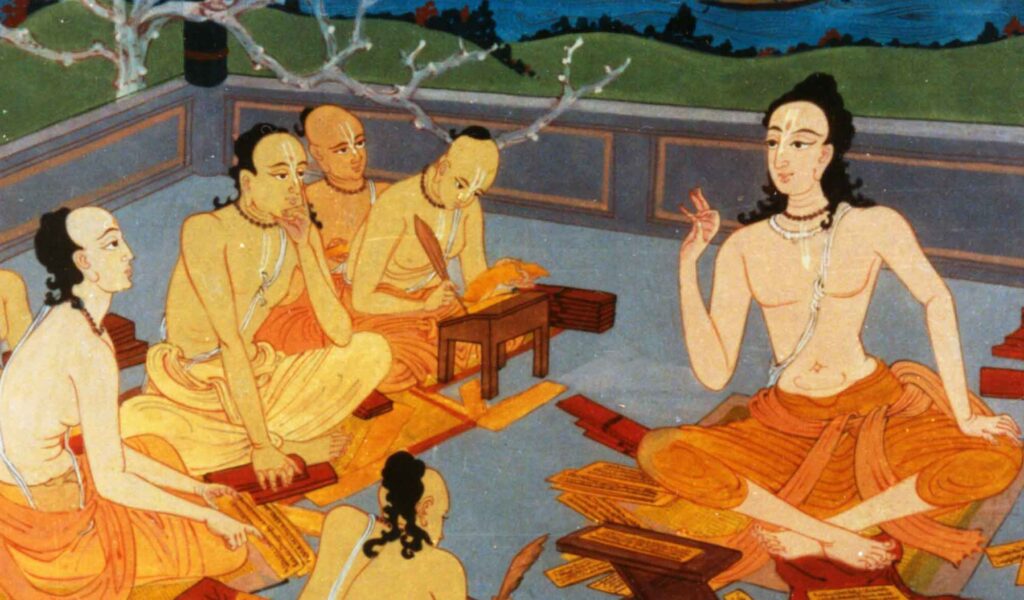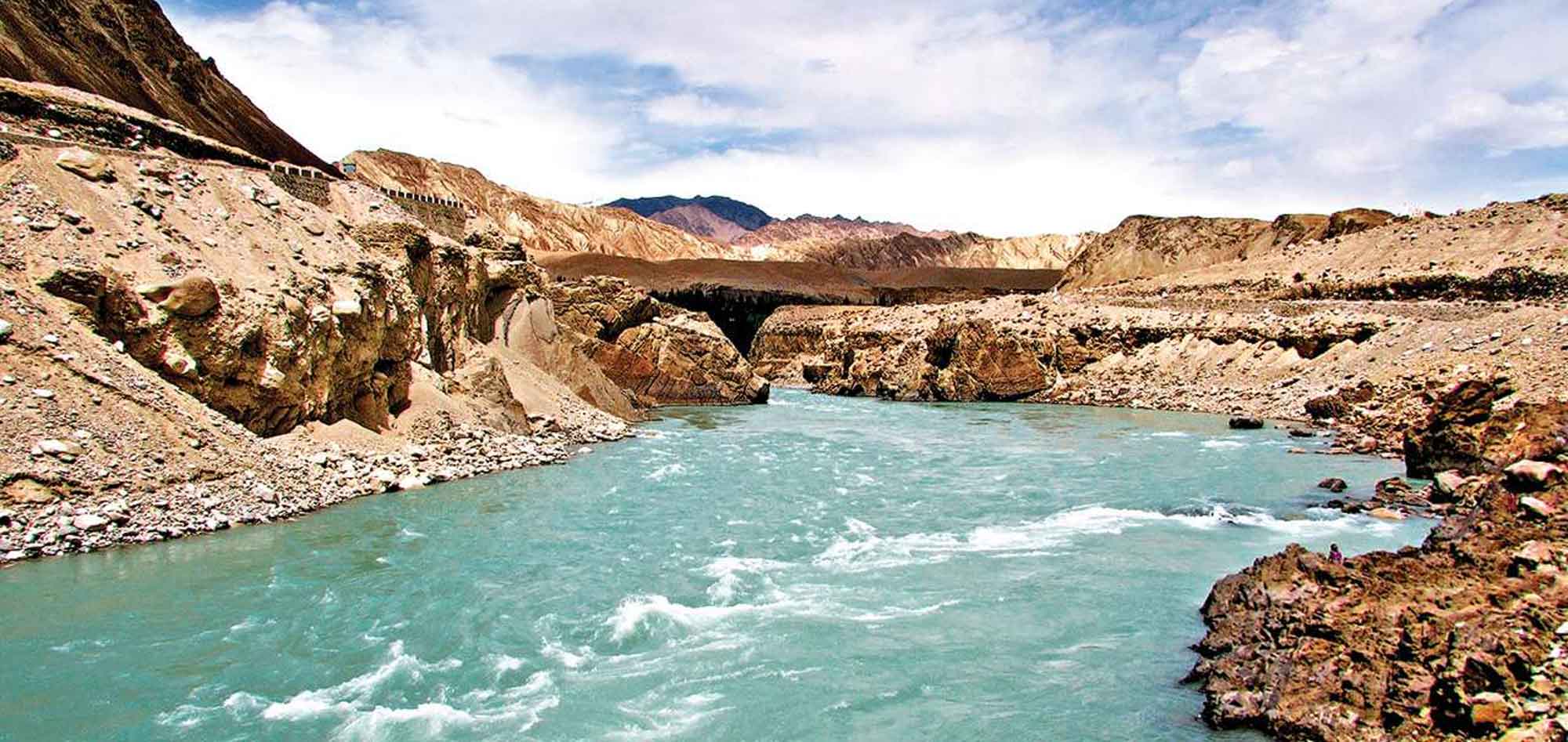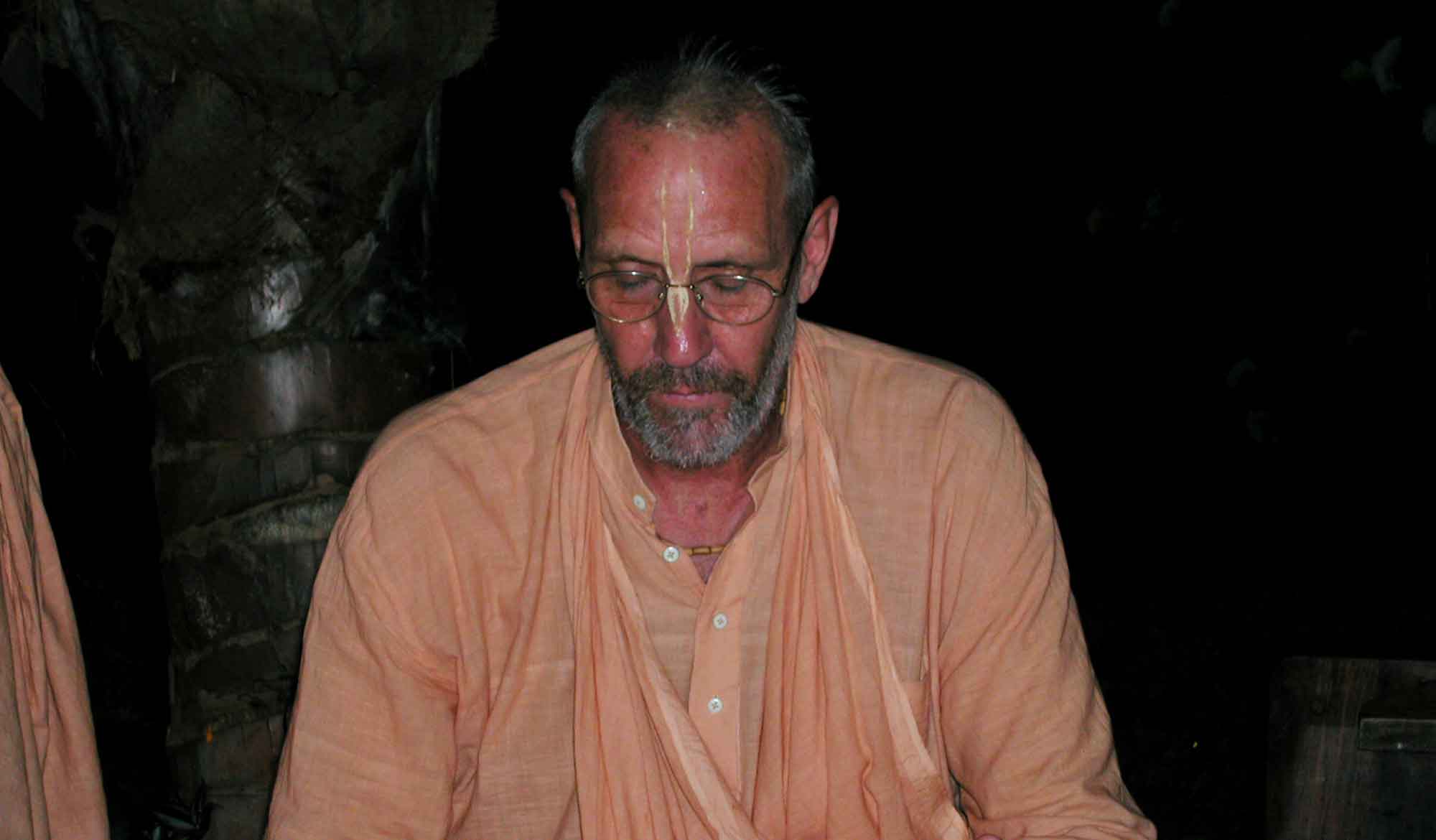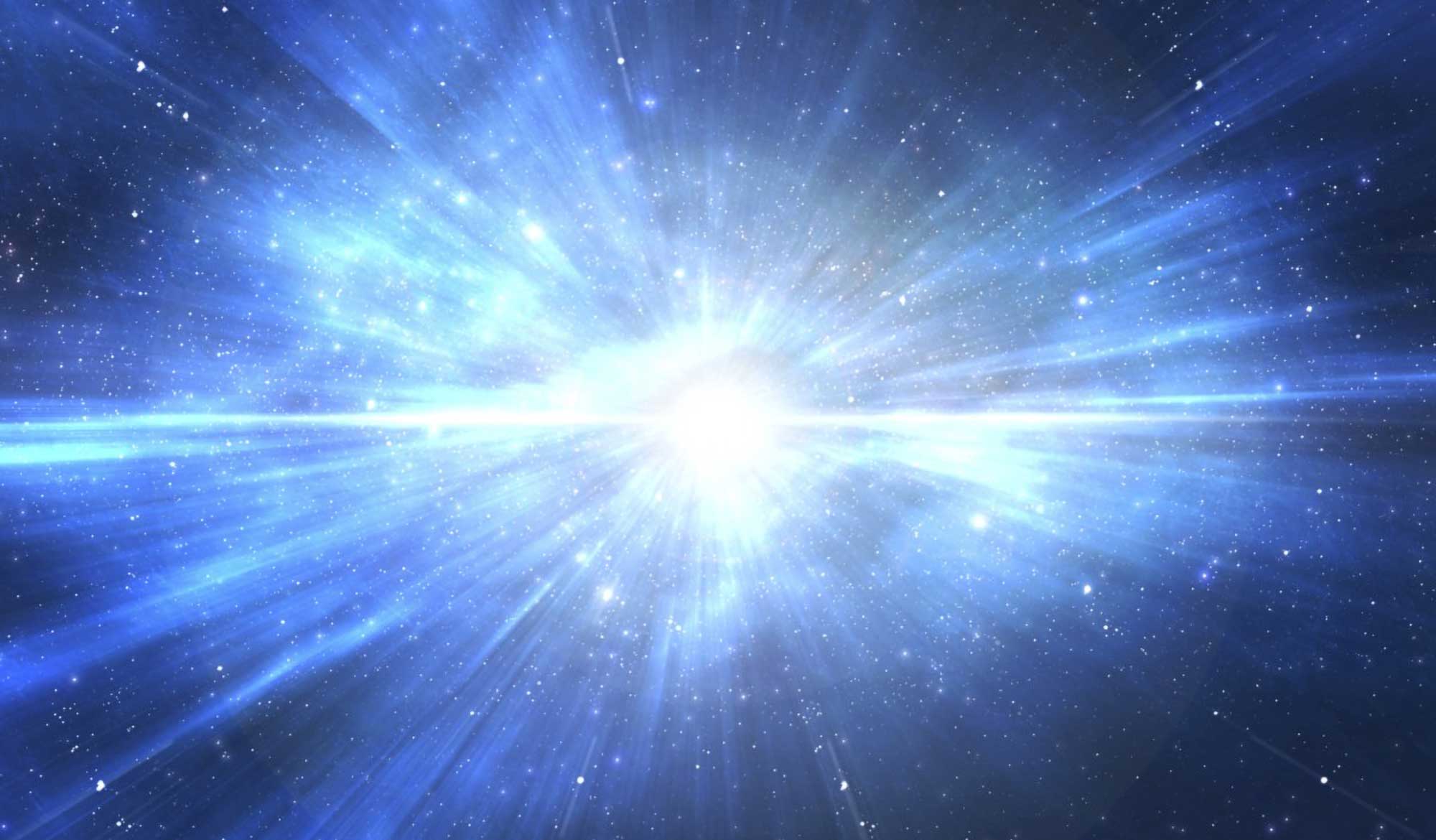by Swami B.G. Narasingha
“The Fall of Kāla Kṛṣṇa Dāsa” was written by Śrīla Narasiṅgha Mahārāja in 1996 in response to the ‘evidence’ for the jīvas apparent ‘fall’ from Goloka, presented in the book, ‘Our Original Position’ (OOPs).
In Our Original Position, the deviation of Kāla Kṛṣṇa Dāsa is stated in chapter twelve as factual and inescapable evidence that the jīva soul falls down from the eternal līla
Commentary
Śrī Caitanya Mahāprabhu rejected Kāla Kṛṣṇa Dāsa from His personal service due to Kāla Kṛṣṇa Dāsa having been allured by gypsies in the region of Mallara-deśa (the area around northern Kerala and southern Karnataka). Kāla Kṛṣṇa Dāsa was a simple and gentle brahmana yet his intelligence became polluted in the association of the gypsies and he became attracted to women. Śrī Caitanya Mahāprabhu being the ideal sannyāsī cannot keep the company of persons who are attracted by women and thus when He returned to Jagannātha Purī He lodged a complaint about the character of Kāla Kṛṣṇa Dāsa before Sārvabhauma Bhaṭṭācārya and rejected him.
The first lesson that Śrī Caitanya Mahāprabhu is teaching us in this incident is that as long as one is in this material world one should never deviate from the strict principles of pure devotional service. Māyā is very strong and the only safety for a devotee in this world is to constantly stick to the lotus feet of Śrī Caitanya Mahāprabhu.
Kāla Kṛṣṇa Dāsa was a brāhmaṇa who was being given the chance to associate personally with Śrī Caitanya Mahāprabhu. We do not find mention anywhere such as in the Gaura-ganoddeśa-dīpikā by Kavi Karṇapura, that Kāla Kṛṣṇa Dāsa was an eternal associate of the Lord who had descended from Kṛṣṇaloka to assist the Lord in His pastimes. Thus it can be understood that Kāla Kṛṣṇa Dāsa was not an eternally liberated soul who fell down from the Lords association but rather he was a candidate from this material world and thus he was still susceptible to māyā’s influence. Had he been an eternal associate of the Lord his “fall down” could only have taken place due to yogamāyā, not mahāmāyā.
Even if one has the personal association of Śrī Caitanya Mahāprabhu, or has become a liberated soul, as long as one still has a material body and is in this material world one should not consider oneself liberated and thus independent of the regulative principles of devotional service. Otherwise one will be captured by māyā. This is the first lesson.
However, Śrī Caitanya Mahāprabhu went immediately to the camp of the gypsies to reclaim His servant, Kāla Kṛṣṇa Dāsa. When this happened the gypsies tried to hurt Śrī Caitanya Mahāprabhu with various weapons. But the weapons which the gypsies tried to use against the Lord turned against them and began to cut them to pieces. Their arms, legs and heads were severed from their bodies. There were loud cries of pain and agony amidst which Śrī Caitanya Mahāprabhu grabbed His servant, Kāla Kṛṣṇa Dāsa, by the hair and saved him.
The second lesson which is to be learned in this incident is that once having taken shelter of the Lords lotus feet the Lord always protects his devotees. Even if there is some accidental fall down on the part of a sincere devotee the Lord rectifies that immediately.
api cet sudurācāro bhajate mām ananya-bhāk
sādhur eva sa mantavyaḥ samyag vyavasito hi saḥ
kṣipraṃ bhavati dharmātmā śaśvac-chāntiṃ nigacchati
kaunteya pratijānīhi na me bhaktaḥ praṇaśyati
“Even if one commits the most abominable action, if he is engaged in devotional service he is to be considered saintly because he is properly situated in his determination. He quickly becomes righteous and attains lasting peace. O son of Kunti, declare it boldly that My devotee never perishes.”
Śrī Caitanya Mahāprabhu went there immediately to save Kāla Kṛṣṇa Dāsa from māyā. In effect Śrī Caitanya Mahāprabhu did not allow Kāla Kṛṣṇa Dāsa to give up His association even though he had been bewildered by māyā. After that it was almost one year before the Lord and Kāla Kṛṣṇa Dāsa returned to Jaganātha Purī. During that time Kāla Kṛṣṇa Dāsa continued to serve Śrī Caitanya Mahāprabhu both day and night. After returning to Purī, then the Lord rejected Kāla Kṛṣṇa Dāsa from His personal association. The Lord did this in keeping with His high standards as a sannyāsī.
The third lesson to learn in this incident is that the Lord’s devotees are even more merciful than the Lord Himself. When Kāla Kṛṣṇa Dāsa was rejected by Śrī Caitanya Mahāprabhu he thus received the mercy of four devotees namely; Nityānanda Prabhu, Jagadānanda Paṇḍita, Mukunda, and Dāmodara.
The devotees of the Lord are more merciful than the Lord Himself. Sometimes the Lord is very hard or strict whereas the devotees are more inclined to show mercy. It is said,
vajrād api kaṭhorāṇi mṛdūni kusumād api
lokottarāṇāṁ cetāṁsi ko nu vijñātum īśvaraḥ
“The hearts of those above common behaviour are sometimes harder than a thunder bolt and sometimes softer than a flower. How can one accommodate such contradictions in great personalities?”
In many incidents Śrī Caitanya Mahāprabhu showed His “harder than a thunderbolt” heart in sometimes neglecting His devotees like Sārvabhauma Bhaṭṭācārya when he fainted on the road or in preparing to punish the rascals like Jagai and Madhai for their offence. However, in many of these cases Śrī Nityānanda Prabhu was there to show Supreme Mercy. Thus was the case with Kāla Kṛṣṇa Dāsa who not only got the mercy of Nityānanda Prabhu but of many other eternal associates of Śrī Caitanya Mahāprabhu also.
At that time Nityānanda Prabhu, Jagadānanda Paṇḍita, Mukunda, and Dāmodara devised a plan and after taking Śrī Caitanya Mahāprabhu’s permission Kāla Kṛṣṇa Dāsa was sent to Bengal to inform all the devotees that the Lord had returned from South India. First Kāla Kṛṣṇa Dāsa went to the home of Mother Śacī and then to the house of Śrī Advaita Ācārya. Kāla Kṛṣṇa Dāsa informed all the devotees about the Lord’s return from South India as well as in great detail all about the Lord’s travels. Kāla Kṛṣṇa Dāsa brought great pleasure to all the Vaiṣṇavas and a great festival was held at Śrī Advaita’s house.
In this way by the mercy of the devotees Kāla Kṛṣṇa Dāsa continued to engage in the service of Śrī Caitanya Mahāprabhu. It should be remembered also that due to the continued services of Kāla Kṛṣṇa Dāsa the narrations about the Lords tour of South India were available for recording in the Śrī Caitanya-caritāmṛta. Even the narration of how the Lord delivered Kāla Kṛṣṇa Dāsa from the gypsies. Those narrations continue to enliven the devotees even up to the present day. Thus the service of Kāla Kṛṣṇa Dāsa continues.
I have mentioned three beneficial lessons for all devotees of Śrī Caitanya Mahāprabhu to follow in regard to the Lord rejecting Kāla Kṛṣṇa Dāsa. However, the idea that the incident of Kāla Kṛṣṇa Dāsa supports the Iskcon misconception that the jīva falls from Vaikuṇṭha or Goloka Vṛndāvana is not acceptable.
We should not think that the Lord has a hatred toward His devotee. On the contrary even if there is some defect in the devotee the Lord does not take that into consideration. All that exists between the Lord and His pure devotees are mutual feelings of love. It is not possible for the pure devotee to envy the Lord nor is it possible for Kṛṣṇa to reject His pure devotee. Whenever such dealings do appear to take place it should be understood to be the workings of yogamāyā not mahāmāyā.
Nothing is more dear to a devotee than Kṛṣṇa and nothing is more dear to Kṛṣṇa than His devotee (na me bhakta priya janaḥ). What more can we say than this.
More Articles by Swami B.G. Narasingha
The Sacred River Sindhu/Indus
‘The Sacred River Sindhu/Indus’ was posted by Swami B.G. Narasingha on his blog, narasingha.net, on October 2nd, 2011. In this short article, Narasingha Maharaja explains the significance of the River Sindhu and his pilgrimage to it. This article was later expanded into a bigger article called ‘Sindhu River – How India Got Her Name.’
Instructing the Guru
This article “Instructing the Guru” was written in April 2018 by Śrīla Narasingha Mahārāja who answers a question concerning a previous article wherein a Vaiṣṇavī writes a letter to her dīkṣā-guru and explains to him about the importance of śikṣā. In response, a question was raised by a devotee about the etiquette of a disciple instructing her guru.
The Atomic Ray – From Uniform Consciousness to Individual Conscious Units
In “The Atomic Ray - From Uniform Consciousness to Individual Conscious Units” written in 1996 Śrīla Narasiṅgha Mahārāja discusses the constitutional position of the jīva, according to Bhaktivinoda Ṭhākura and Śrī Caitanya-caritāmṛta.













